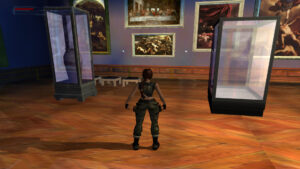TR6: The Obscura Code
 Sometimes — not always, but sometimes — Tomb Raider: The Angel of Darkness feels like it was written for a different character. Like how the movie version of Days of Future Past swapped out Kitty Pryde for Wolverine because he was an easier sell. You could imagine that happening with Lara Croft, couldn’t you? I don’t think the idea is at all supported by the game’s development history, though — as far as anyone knows, it was pitched as a Lara Croft game, and any differences in feel from the previous Tomb Raider games are just the result of the developers trying to break the franchise out of a rut.
Sometimes — not always, but sometimes — Tomb Raider: The Angel of Darkness feels like it was written for a different character. Like how the movie version of Days of Future Past swapped out Kitty Pryde for Wolverine because he was an easier sell. You could imagine that happening with Lara Croft, couldn’t you? I don’t think the idea is at all supported by the game’s development history, though — as far as anyone knows, it was pitched as a Lara Croft game, and any differences in feel from the previous Tomb Raider games are just the result of the developers trying to break the franchise out of a rut.
If it’s not taking its design cues from previous Tomb Raider games, what is it imitating? It’s been pointed out that the stealth mechanics and optional nonlethal weapons are basically out of Metal Gear Solid, but honestly I’ve been able to get away with almost entirely ignoring stealth elements, even in a scene in the Louvre gallery at night when you’d think it would be useful. Rather, the most striking apparent influence is The Da Vinci Code.
And if that is a genuine influence, rather than a set of mere coincidences, it must have been a pretty quick turnaround: DVC was released in April 2003, TR6 in June of the same year. That’s barely even enough time to get a game through certification, let alone rewrite its plot. But consider the similarities. In both, we start off investigating a murder — in DVC, the victim is a curator at the Louvre, in TR6, an archeologist who was working with a researcher at the Louvre, who is also murdered in short order. Both involve clues encoded in artwork — in TR6, a set of sketches indicate the locations of the “Obscura paintings”, which have secret alchemical glyphs under the paint. One of the Obscura paintings is apparently located deep underneath the Louvre, where the final secret in DVC was located. DVC has people looking for the Sangraal, TR6 for something called the Sanglyph. Both involve secrets about divine bloodlines: descendants of Christ in DVC, nephilim in TR6. And in both, you’re opposed by a sinister Latin-named religious group that’s willing to murder people to keep its secrets: Opus Dei in DVC, Lux Veritatis in TR6. (The latter of which makes me wonder if they all went to Yale or something.) This is enough to make me think that even if the main plot was already set before the designers read DVC, they probably at least tweaked some details at the last minute to make it more DVC-like. Some of the above is only found in text form, in Von Croy’s notebook, and thus wouldn’t involve time-consuming alterations like recording new voice lines.
Tangentially, there was an official game adaptation of The Da Vinci Code, released in 2006 to coincide with the film adaptation. I played it, mainly because if anyone asked me if I had read the novel or seen the film, I wanted to be able to answer “No, but I’ve played the videogame.” I understand that the game takes considerable liberties with the source material. Where the source has a cryptex, the game has multiple nested cryptexes (cryptices?) to make for better gameplay. Opus Dei is renamed Manus Dei out of consideration for (or in response to complaints from) the real Opus Dei, an organization that, whatever you might think of them, has never been credibly accused of being a front for the Pope’s hitmen. I find myself wondering if the makers of the DVC game played TR6, and if there are any ideas they stole back from it.
 Comments(0)
Comments(0)